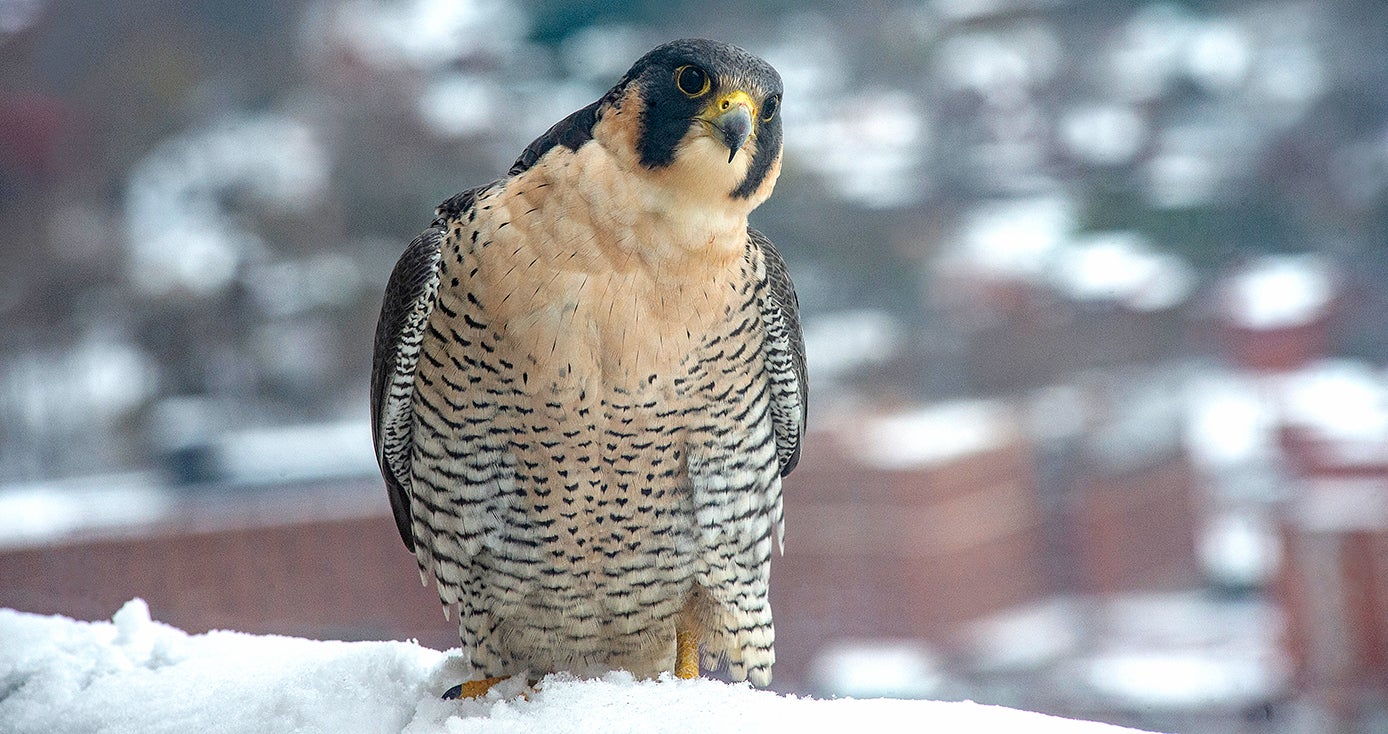
Subscribe to Pittwire Today
Get the most interesting and important stories from the University of Pittsburgh.Pitt Peregrines Welcome St. Paddy’s Egg
High above the city, a queen reigns, defending her territory, protecting her young and dancing with her mate. Every season brings new drama—attacks from rivals, new life and questions of paternity.
This isn’t a “Game of Thrones” reenactment, but it is quite the show: It’s the life and times of the peregrine falcons who nest outside of the Cathedral of Learning’s 40th story, which you can watch unfold on the National Aviary’s livestream.
The latest pair to make their home at Pitt are Morela—named after the Polish word for apricot, due to her coloring—and Ecco. On March 17, they welcomed their first egg of the season. Most females will lay three to five eggs, with one or two days between eggs, before starting to incubate the clutch.
A dear—and disturbing—campus sight
The rapturous epic began in 2001 when blogger and birder Kate St. John spotted two peregrines courting near the Cathedral. Encouraged by the nesting behavior, St. John convened the Western Pennsylvania Conservancy, Pennsylvania Game Commission and the University of Pittsburgh to install a nest box in 2002.
Back then, Paul Supowitz, now Pitt’s vice chancellor of community and governmental relations, was working in the Office of University Counsel on the 24th floor when the call came in. He recalls the memory fondly: “I didn’t know much about peregrines then, but it was a no-brainer for us to help. In order to draw up paperwork for the nest box, I wanted to go out onto the ledge to see it.”
The falcons had left a surprise for him: A decapitated duck head left over from a meal.
“It was like a warning from ‘The Godfather,’” he joked. “Getting to know these birds the last 19 years, watching their different personalities, it never gets old. I’m glad Pitt is a part of bringing falcons back to Western Pennsylvania after decades on the endangered species list.”
And as Supowitz discovered, trying to save the species can be gruesome. In recent years, a prior female tenant named Hope disturbed viewers by eating some of her chicks. While this was highly unusual falcon behavior, it demonstrated the value of the aviary’s livestream to researchers who study raptors. Hope vacated the nest in 2019, after a four-year stay.
Morela has proven more traditional. Last year, she laid two eggs at the nest after a complicated love triangle with Ecco and another male, Terzo. St. John explained that Ecco, who was only a year old in 2020, was not yet old enough to breed. Even still, Terzo was not able to chase Ecco away permanently, and the two continued their rivalry. Neither mate helped her incubate the eggs, and the nest failed.
“Terzo is now gone forever as far as I can tell. He was last seen on Feb 5. Ecco is clearly in charge, so I am quite hopeful this will be a successful nesting year,” St. John said, noting that viewers will want to be on the lookout for both parents taking care of the eggs.
“When Morela starts incubation, Ecco will relieve her at least once a day,” said St. John. “She will incubate all night. Ecco will probably take over while she eats breakfast and for a period during the afternoon. But each couple has their own routine. We'll have to wait and see.”
If all goes well, chicks could hatch in late April or early May. But despite the auspicious date of the first egg, none of the chicks will be named Paddy. As St. John shared on her blog, in Pittsburgh, nestlings are named with a letter indicating the site where they were born and a number indicating the order in which they hatched. This gives local nest monitors the option to name adult birds once they’ve settled in a location—which is how Morela and Ecco got their monikers.


